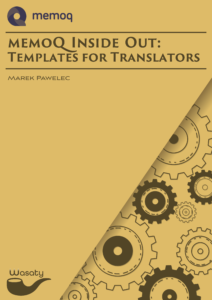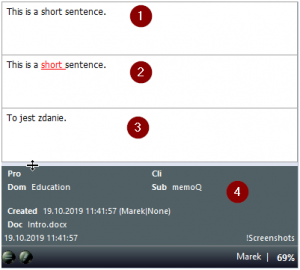Tweet Translation and revision are almost always tasks that require some organization and management. We receive jobs from our clients, often with some additional resources, like TMs, TBs and references. We also need to be able to track our progress on jobs we do, which involve different tasks. All this led to introduction of project-based …
Category: Uncategorized
Oct 20
Literary translations with CAT tools
If you deal with literary and creative translation only, you have probably never used any special translation-related software other than dictionaries (and a word processor), but you may have heard of “Computer Assisted Translation” tools or CATs for short. These were developed with technical translation in mind, and their main premise is to “never translate the same sentence twice”, which makes a lot of sense in the world of repetitive instruction manuals, but can this be useful in literary translation? Let’s see, but please note that this text does not touch the subject of machine translation (MT).
Oct 29
Terminology mining from Eur-Lex corpora
Tweet The conference #TranslatingEurope Forum 2016 was held on October 27-28 in Brussels. Besides presentations, the conference included two sessions of mini-workshops: the idea was to present some practical aspect of translation in small group – three people at a time. The workshops included my submission on terminology mining. I realized from the start that participants won’t …
Dec 16
Multilingual set of H and P statements
Tweet Pressed by a review job I’ve finally compiled a comprehensive list of H and P statements from Regulation (EC) No 1272/2008 of the European Parliament and of the Council. If you don’t know the regulation, then you probably do not need the list. However, if your translation cover MSDS, CLP or GHS-related subjects, the statements …
Jun 22
Tłumaczenie plików XML – część 1: wprowadzenie
XML ma złą reputację wśród tłumaczy – bardzo często jest postrzegany jako coś skomplikowanego, co niezwykle trudno prawidłowo przetłumaczyć. Jednak dysponując podstawową wiedzą na temat struktury plików XML oraz nowoczesnymi programami do wspomagania tłumaczeń tak naprawdę praca z plikami XML jest dość prosta. Niniejszy tekst jest pierwszym z trzyczęściowej serii na temat tłumaczenia plików XML. Część pierwsza to podstawowe wprowadzenie do formatu XML – takie „co i jak”. W części drugiej omówię import plików XML do programu memoQ, a w części trzeciej do programu Trados Studio.
May 28
Prezentacja memoQ i 42% zniżki
Tweet W najbliższy czwartek, 30 maja, w serwisie Proz.com odbędzie się „Wirtualny dzień memoQ” – seria prezentacji i spotkań na żywo, podczas których będzie można zapoznać się z funkcjami oferowanymi przez program, poznać różne aspekty pracy z nim, zobaczyć najnowszą wersję programu (wersja 2013) oraz kupić memoQ ze zniżką 42%. Zniżka dotyczy wszystkich, którzy zarejestrują …
May 30
Importing glossary entries to MultiTerm
MultiTerm is a powerful software, but it was clearly written by people with a mindset completely alien to most of the people who are supposed to use it. Translators, for whom Trados was the first CAT tool often does not value glossaries too much, simply because Trados does not encourage the use of glossaries. Creation and maintenance of MultiTerm glossaries is not a something very simple, and even such – it would seem – trivial task as generating a database from glossary in Excel file can be a real pain. Is it possible to import a glossary in a quick and painless way? Read on.


